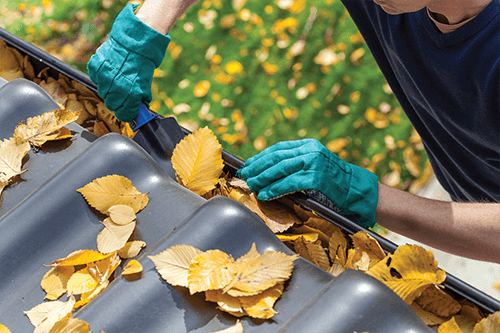Fall is officially here (even in Texas), and it's time to make sure your home is in peak condition before temperatures start to drop. It's a busy time of the year and also one of the most enjoyable times to be outdoors. Take advantage of the moderate weather now and protect your home or property from treacherous winter conditions with these pro tips from Bob Vila!
Exterior Maintenance
- Check your home's foundation for cracks. Repairing cracks will help prevent heat from escaping and is one of the least expensive maintenance jobs, according to Michael Hydeck, National President of the National Association of the Remodeling Industry (NARI).
- Repaint any peeling or blistering paint. If your paint is peeling, it means it can no longer protect your home's exterior, leading to future expensive repairs.
- Inspect the roof for missing or loose shingles. Ice, rain, snow, and wind can wreak havoc on your roof, and water damage can occur. Avoid damage to insulation, wood, drywall, electrical, plumbing, or HVAC systems by proactively dealing with repairs this fall. Hire a certified roofing professional to knock this one off the list.
- Clean gutters and downspouts. Inspect joints and tighten brackets if necessary. Replace old or damaged gutters.
- Caulk windows and apply weather-stripping to doors. Make sure the seal between your garage door and the ground is tight to prevent drafts and keep unwanted animals out. Cute fluffy raccoons belong outside, not curled up next to your SUV.
- Install storm windows and doors and remove screens. Clean and repair the screens, spray with a protective coating and store them in a dry area of a basement or garage.
Interior Maintenance
- Have your heating system checked by a professional before the cold weather starts. Heating systems will run more efficiently and last longer when they are properly serviced. Your HVAC uses the largest amount of energy in your home, so keeping it in tip-top shape will help save you money in the long run!
- Change the direction of your ceiling fan. In the fall and winter months, an upward draft will redistribute the warm air from the ceiling.
- Change batteries in smoke and carbon monoxide detectors.
- Ready the fireplace. Have your chimney cleaned by a licensed chimney sweep to prevent a fire. If you feel a draft around your chimney (cold in winter/warm in summer), you may want to check and see if your damper has a tight seal. You may accidentally be leaking away your HVACs hard work.
- Check windows for drafts, loose frames, or cracked panes. Heating and cooling are one of your home's biggest energy costs; proper sealing and insulation can save you up to 10% on your total annual energy bill.
- Remove window air conditioners or cover outdoor units. Use an approved tarp or plastic air conditioner cover to prevent rusting.
Yard & Garden
- Clear leaves from your lawn, reseed patchy areas and plant spring-flowering bulbs. If you have a pool, examine your cover for any damage and replace it if needed.
- Get organized. Clean and store summer garden tools and drain the fuel from gas-powered lawn equipment like mowers, blowers, etc.
- Ready your snow equipment. Check to make sure everything's working before the first snowfall. You will be glad you did!
- Drain hoses and shut off outdoor water valves. Any leftover water in exterior pipes could cause freezing and expansion, breaking the pipes.
- Prepare for the animals. If deer are a problem, cover your plants with netting and chicken wire. If you use a bird feeder, keep in mind that once you start feeding the birds, you should continue to do so regularly throughout winter. They are depending on you now.
Porch and Deck
- Check porch and deck supports, stairs, and railings. Make any necessary repairs now to prevent further damage.
- Clean and apply a sealer to decks.
- Cover and store outdoor furniture, grills, etc.
- Empty dirt from flower pots and containers, soil left in clay pots will freeze and cause the pot to crack if left outside.
Some readers may know some of these "tips" by heart, but new homeowners should take note. Familiarize yourself with the conditions of the area in which you live now versus later. It should go without saying, but it's much easier to prevent hundreds, if not thousands, of dollars in damage rather than learning a lesson the hard way. So break out those Fall decorations and be sure to not only decorate your home but protect it too.
